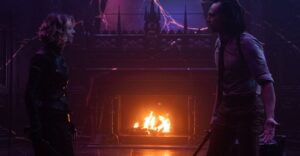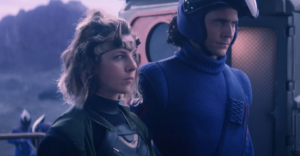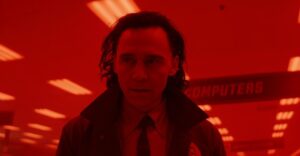Loki episode 1.01 “Glorious Purpose” is a perfect entry into this series and serves as a flawless deconstruction of a character we thought we knew to a tee via a simple writing tool: exposition and payoff.
This episode was frakking good. I enjoyed every second of it. But why? When it comes to these MCU shows on Disney+ (#NotASponsor) what matters most to me, and I suspect what matters most to you too, is CHARACTER.
What are we learning about Loki and how do these events inform his presence within the MCU writ large?
After 25 films, two Disney+ series, I care about these characters, and I specifically care a lot about Loki. Like in WandaVision though, we finally have a chance to explore the people behind the actions which take place in the tent pole extravaganzas. The perfect example of this is when Owen Wilson’s TVA Agent Mobius M. Mobius simply asks Loki, “do you like to hurt people?” Could you ever imagine Thor, or, say, Tony Stark, sitting down with Loki and asking him that question in any of the Avengers films?
There is neither the time, nor the bandwidth to explore that kind of nuance in the uber-villain that is Loki in a MCU style film. This series, however, makes it abundantly clear that this nuance is the exactly the kind of ride for which we are in store. Why do we know this? Ultimately, this episode doubles as one giant therapy session for Loki and how he must come to accept how his actions led to his mother’s death, how he really had no tactile plan for ruling Midgard (Earth) or face the existential dilemma that his “glorious purpose” leads to nothing but his neck being snapped by a giant purple alien who bankrolled his Midgard take-over from the beginning.
This all sounds well and good, but the question still remains – why is this such a triunphant starting point for Loki? Because we learn more about Loki, a character we have come to love, through a clever use of exposition and payoff.
Here’s the big question: what is “exposition”?
Exposition is when the film or show stops engaging its plot to inform the viewer what they are actually seeing on screen. Instead of the series “showing” you its story, it’s now telling you a functional aspect of its story so you can understand the context for the remainder of the narrative. This is dangerous because people know when they’re being talked at, and, in the end, exposition can be confusing, frustrating, or downright boring.
In his book “Story“, Robert McKee writes the following about exposition:
If at a certain point in the telling, a piece of exposition must be known or the audience wouldn’t be able to follow, create the desire to know by arousing curiosity. With a hunger for information, even the most complicated set of dramatized facts will pass smoothly into understanding.
In other words, if you have to inform your audience information they wouldn’t, or can’t, normally get from the immediate story you’re telling, then you must exposit to catch them up. The trick is to exposit in an interesting fashion so as not to lose the momentum of your story. Exemplary instances of interesting exposition in film are:
Mr. DNA from Jurassic Park:
The Tale Of The Three Brothers in Harry Potter And The Deathly Hallows: Part I:
The Construct Scenes from The Matrix:
For our purposes here, let’s stick with comparisons to The Matrix because I believe the two scenarios in The Matrix and Loki are relatively comparable. The two main characters are ejected from their world into a brand new plane of existence and we, the audience, need to learn as much about those new planes as quickly and efficiently as the main characters in order to understand each story.
Despite being comprised of mostly exposition in its storytelling, The Matrix is arguably one of the top fifteen films ever made. It does this by generating curiosity in the beginning, defining its rules in the middle with striking visuals and inventive action, and revealing a truer sense of its main character by the end of the film. While it may not be as groundbreaking as The Matrix, Loki follows a similar structure and that it is why it is such an effective beginning to this show.
After catching us up to date by showing the events of Avengers: Endgame “time heist” — which serves as a sort of prologue to Loki — the story piques our curiosity in a compelling fashion by literally dumping Loki of in the Gobi Desert. Our first shot after the prologue is a drip of water hanging off a rock which reflects a bug crawling across the sand. Notice, though, the reflection is upside down and warped through the lens of the water. The show is telling you that it’s about to turn Loki the character, and the MCU as you understand it, completely upside down through a lens of a totally new existence.
Loki lands in the desert alone and unable to communicate to the characters surrounding him, but still tries to maintain his superiority by standing on a nearby rock and proclaiming, “I am Loki of Asgard and I am burdened with glorious purpose.” But he is interrupted by TVA agents who appear out of some spectral doorway who define his actions as nothing more than a “standard sequence violation.” Agent B-15 continues to assess the situation by saying, “the branch is growing at a stable rate and slope, and variant identified…on behalf of the Time Variance Authority, I hereby arrest you [Loki] for crimes against The Sacred Timeline.” Notice that it’s not for killing thousands of people in New York, or, yanno, invading earth with an alien army. Then it’s topped off by Loki getting whooped across the face in 1/16 speed while the agent continues in normal speed putting some kind of collar on his neck, and the other agents placing this little object on the ground to “reset the timeline.” Wow. That’s already a lot, and we’re only two minutes into the actual story.
This works though because it’s a perfect set up for all that is about to come. The TVA is powerful, it controls timelines, it has soldiers who are more powerful than Loki, and Loki is completely alone with none of the bravado that usually instills fear in his counterparts. In comparison to the TVA, he is weak, defenseless, and utterly powerless.
Loki is then brought to the overtly 70’s style of the TVA offices, and the TESSERACT — which we know is an INFINITY FRAKKING STONE — is treated as a minute piece of evidence that can be tossed aside like it was nothing more than a belt buckle found at a crime scene. Loki’s clothes get burned off and he is put into a prison suit, he must sign for every word he has ever said in what is a truly genius sequence, and then he must consider if he is actually a robot before he is scanned and potentially eviscerated by the scanner. Then we are introduced to the incredibly effective “Miss Minutes” who explains the timeline logic (notice the extreme similarity to Mr. DNA from Jurassic Park) and Loki is then shown how he can be obliterated if he didn’t take his ticket.
Boom, opening titles.
This entire introduction is outstanding.
We understand the character, the emotional connection, how he is powerless in the TVA, the stakes, and we are provided an inroad to how the world works, but are left with enough questions about the Time Keepers and the function the TVA performs to keep us coming back for more.
The first half of the episode continues to bombard us with more questions, who are the Time Keepers, who is Mobius, what is the deal with France in 1549, how does all this work, is the TVA an illusion, what is the Nightmare Division, where does the TVA exist, how does the collar on Loki work, why does Loki have to plead guilty, what is a “dangerous variant”, and if Loki is a little “pussycat” in comparison to those dangerous variants, then why is Mobius so interested in using Loki as his personal Hannibal Letcter – so on, and so on, and so on.
Questions keep ramping up through the first interview with Loki until he finally stands up in frustration and tries to grasp on to whatever inkling of control he may yet retain in the TVA by saying, “I know what this place is – it’s an illusion. It’s a cruel and elaborate trick conjured by the weak, to inspire fear; a desperate attempt at control.” (remember this line.)
But, like in The Matrix, Loki must be shown how much power the TVA wields, and how everything he has done (up until stealing the Tesseract) has been because the have ALLOWED him to do so. It’s at this point we’re introduced to what is essentially a powerpoint presentation of Loki’s greatest hits – including how he bound the greatness of the Avengers together, and essentially caused the death of his mother.
For the first time in the history of his character, we finally see a humbled and subdued Loki who begins to understand he might be over his head. “What is this place?” Loki asks in a seemingly defeated fashion. Still hanging onto the notion as being the god of mischief, however, Loki tries a last ditch effort to steal the controller for the timey-wimey collar from Mobius, escapes to find the Tesseract, and goes full on to get the hell out of dodge. This is important because Loki can’t accept his futility, and refuses to believe the amount of power the TVA wields over him. Before it becomes too much though, head writer Michael Waldron makes the astute choice to finally give some answers after all the questions, false starts, and intentional ambiguity.
Loki finds the Tesseract among all these other pieces of “evidence”, but it’s not just evidence as we know it. They are Infinity Stones, and we get to see Tom Hiddleston at his very best when Loki realizes they have no power here in the TVA. They’re just paper weights for a bunch of nerdboys who don’t even know what fish are.
Loki the show is also at it’s very best here because there is no more talk, no more explanation, no more info dumps – it uses the visuals it’s established, our preconceived notions how powerful the Infinity Stones are SUPPOSED to be, and it let’s Hiddleston’s supreme acting, as well as the score, do the talking for it. Hiddleston’s look of bewilderment and shock as he walks into the middle of the office space — holding the Tesseract as the paperweight it really is — emphasizes one major point: the Tesseract is useless here. Loki’s entire pursuit of power for his whole life, is useless here. He, and the Tesseract, are meaningless while everyone around him goes about their daily business with no care about him at all. It’s a stark contrast to how Loki proclaims himself in the beginning of the episode. No, he is not burdened with glorious purpose. He has no purpose.
Sure, Loki tries to escape one more time and it plays off as all fun and games — especially as the exposition is embedded deeply into the action that proceeds between Loki and B-15. But instead of continuing to teach us about its guidelines, or expanding the rules which dictate the TVA, the action simply reasserts the exposition already accomplished earlier in the episode.
So it makes sense to us when we see Loki control the collar he has attached to agent B-15 and how he can manipulate her through time. When Loki is eventually threatened with the death sticks, we can appreciate what will happen to him if he doesn’t comply. And when we see the TVA screen start to play Loki’s life ahead of him, we empathize with his tears as he sees his reconciliation with his brother, his father, and eventual death. He finally knows the answer to the question he asked earlier in the episode, “is this the greatest power in the universe?”
I began this essay though stating that not only did the show succeed because of its exquisite use of exposition, but also because of its payoff. What is that payoff?
Loki is treated as a buffoon in this episode, because that’s exactly what he is in the TVA. Remember, this is Loki right after he is caught in The Avengers, when he is probably at his most arrogant and insufferable. As such, he needs to be taken down a notch. To borrow a quote from Nicky Fury, Loki the proverbial ant who has a quarrel with a boot, but the boot just treats him like an ant. That’s the point. This doesn’t denigrate his character, or undersell his power on earth – but rather, it reaffirms how ineffectual and vulnerable Loki is in this realm. To the TVA, Loki’s an ant, and through the exposition we have an incredible payoff at the end of the episode when Loki realizes he can’t go back to his timeline and he recontextualizes the line you had to remember from earlier in this article.
Like Neo’s journey in The Matrix, Loki generates curiosity in the beginning of the episode, defines its rules in the middle with striking visuals and inventive action, and we honestly believe the payoff for all this exposition when Loki the character reveals a truer sense of himself by the end of the episode…
I don’t enjoy hurting people…I don’t enjoy it. I do it because I have to. Because I’ve had to….It’s part of the illusion. It’s the cruel elaborate trick conjured by the weak to inspire fear and a desperate play for control.
But also like the tease at the end of The Matrix, when Neo tells the computers that he is coming for them, Loki provides an expert tease – Mobius needs Loki because the dangerous variant he is hunting, is actually Loki.
Mary & Blake certified: A+
APROPOS OF NOTHING FOR LOKI EPISODE 1.01 “GLORIOUS PURPOSE”
- Tom Hiddleston and Owen Wilson have incredible chemistry together. Especially as Wilson plays the gee-wilikers straight man of the pairing.
- “You’re really good with metaphors. Makes you sound really smart.” — “I am really smart.”
- Natalie Holt’s score is BY FAR the best score from any of the Disney+ series’ yet. And I would argue its among the best in the MCU overall.
- One of the Time Keepers is apparently referring to Kang The Conquerer. I’ll leave it at that because the character is supposed to be played by Jonathan Majors in the upcoming Ant-Man And The Wasp: Quantamania. Spoiler free here.
- There is apparently a reference to Peggy Carter – who appears to be arrested and brought into the TVA in the background while Loki is running around. I wonder if Steve Rogers is arrested by TVA for his foray into another timeline?
- The two armies fighting in the Miss Minutes cartoon appear to be The Kree (from Captain Marvel) and the Wakandans. Hmmm….
- According to Miss Minutes, variants like Loki cause Nexus events – or unauthorized breaches of the sacred timeline. That word Nexus should sound familiar because it was used in WandaVision’s antidepressant commercial.
- Miss Minutes also says that a Nexus event could branch lead to “madness” resulting in a multiversal war. II don’t think it’s a coincidence that Wanda heard her children’s “voices” at the end of WandaVision, and she will be the co-lead of the upcoming Doctor Strange in the Multiverse of Madness.
- Having Loki be the D.B. Cooper in this universe because he lost a bet to Thor is a stroke of genius. By the way, go watch “The Mystery Of D.B. Cooper” documentary on HBOMax. It’s incredible.
- There logic in the time travel here is still a little wonky, but I don’t really care. Ultimately Ravonna the judge gives us a catch-all reasoning — the Avengers could time travel because that’s what was supposed to happen. No timelines can pop up without approval. So whatever exists is approved by the Time Keepers.
- Note that the TVA recognizes Loki as Loki Laufeyson, not Odinson. A fun callback to Loki’s true origins.
- Note also that when Loki is ejected into the Gobi Desert, it’s almost a shot for shot remake of how Iron Man lands in the desert in the first Iron Man after escaping.
FOLLOW ALL OF OUR COVERAGE OF LOKI HERE
SEE THE REST OF THE MCU DIARIES COVERAGE HERE:
All The Falcon And The Winter Soldier Episodes












